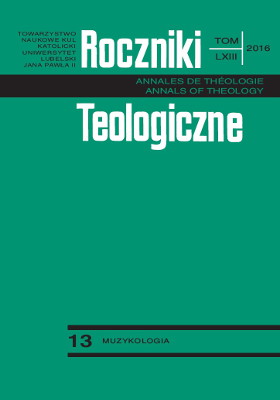Kompozytorzy muzyki instrumentalnej zachowanej w archiwum opactwa cystersów w Krakowie-Mogile. Problem atrybucji
Composers of Instrumental Music Preserved in the Archives of the Cistercian Monastery in Kraków-Mogiła: Attribution Problem
Author(s): Dariusz SmolarekSubject(s): Fine Arts / Performing Arts, Music
Published by: Towarzystwo Naukowe KUL & Katolicki Uniwersytet Lubelski Jana Pawła II
Keywords: 18th century instrumental music; 18th century composers; musical culture of the Cistercian monastery; instrumental music repertoire of the Cisterian monastery in Kraków-Mogiła
Summary/Abstract: In many monasteries of the 18th century Poland, there were vocal-instrumental ensembles. Their repertoire consisted mostly of songs designed for liturgy and religious services. An interesting fact is, that besides religious music, church ensembles had also strictly instrumental works in their repertoires. One of the largest and well preserved volumes of such music, is the musical collection of the Archive of the The Sanctuary of the Holy Cross of the Cistercian Abbey in Kraków-Mogiła. The problematic aspect presented in the article, indicates that among the 87 instrumental works from the collection in Kraków-Mogiła, only 19 are anonymous, and from those, 6 compositions have an uncertain attribution. The collection of notes includes 68 individual instrumental works which originate in the following music centers (names of only a number of composers will be presented as examples): Mannheim (J. Stamitz, A. Fils, G.B. Toeschi), Berlin (F. Benda, brothers C.H. Graun and J.G. Graun), Dresden (J. Adam), the Czech Republic (F. Brixi, A. Laube, A. Neumann), Vienna (G. Ch. Wagenseil, K Ditters von Dittersdorf, J. B. Vanhal, V. Pichl, J. Haydn, L. Hofmann), London (C.F. Abel, J.Ch. Bach, A. Kammel, I. Raimondi), Italy (and especially Naples—P. Anfossi, P.A. Guglielmi, G. Paisiello and Milan—G.B. Sammartini) and Poland (J. Gołąbek, A. Fischer).The preserved musical collection of the Clarae Tumbae is a perfect example of a repertoire representativeness (orchestral and not only) of one of the most important music centers of the 18th century Poland and a relevant, at the time, ensemble.
Journal: Roczniki Teologiczne
- Issue Year: 63/2016
- Issue No: 13
- Page Range: 173-202
- Page Count: 30
- Language: Polish

